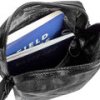I use a two part system. The more important an item is, the closer to me it is - at all times.
For example, first-tier item, like: Passport, money, credit cards, pilgrim credencial, multilingual ICE (in case of emergency) instructions, personal documents like insurance cards, drivers license, and cell phone - these almost never leave the cargo pockets of my hiking pants. Each pocket has a heavy duty, vertical load zip lock bag to protect the contents from full water immersion - like falling into a stream or river. It has happened to me on more than one occasion over my several Caminos. I did not go swimming, but I did get thoroughly wet.
The pants come into the shower with me to be hung immediately next to me, so I can get redressed immediately afterwards. If I am sleeping in an albergue, the pants are stuffed in my sleep sack.
The second-tier items, electronics, prescription medications and anything else that, the loss of which, could effectively end my Camino, ride in a small (3-5 liter) waterproof "belly bag" that fastens / clips to the FRONT of my rucksack harness.
When I stop for any reason, I unsnap it and use the provided shoulder strap - cross body. It always stays where I am and would be hanging under my pants, next to an albergue shower.
This 'belly bag' also serves as a waterproof protection for the previous mentioned cargo pocket contents if I am unable to hang the clothes directly next to my showering activities. During the day, when contents are moved to pants cargo pockets, the extra space is for snacks. My belly bag has two, side water bottle pockets for .5 liter water bottles.
Each person should experiment to find their idea carry solution. It is not a one-size fits all thing.
Hope this helps,
Tom



























